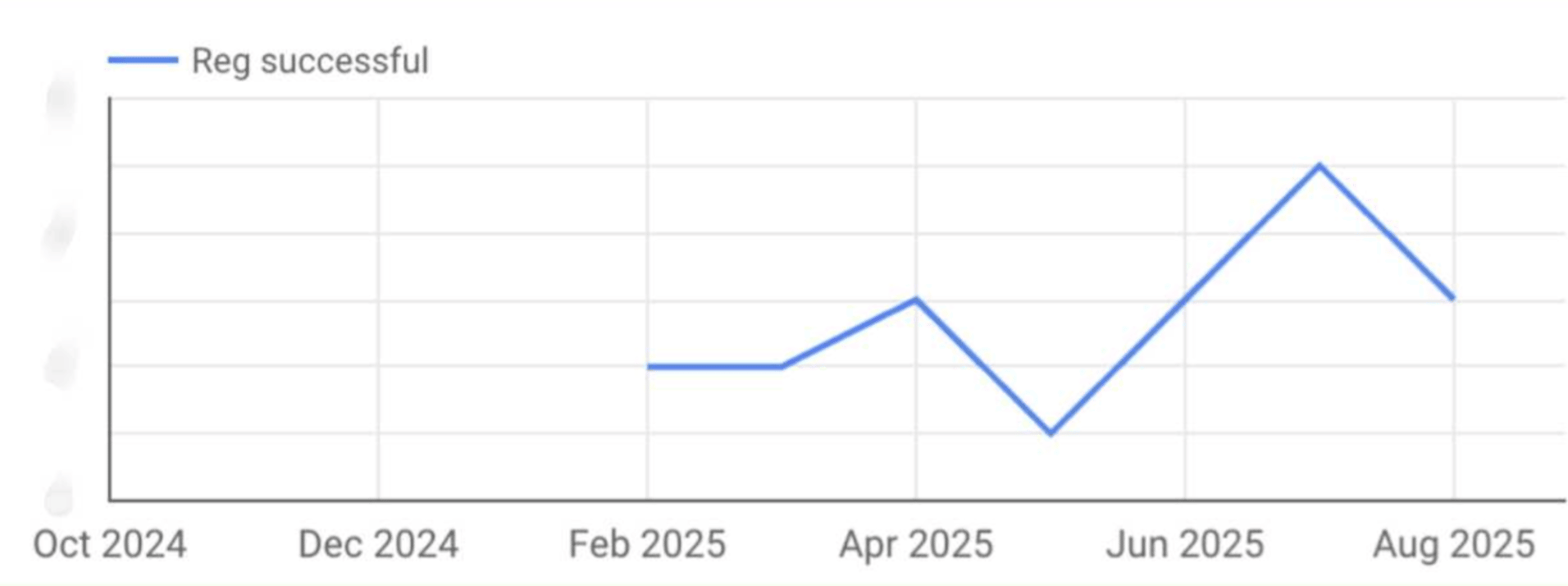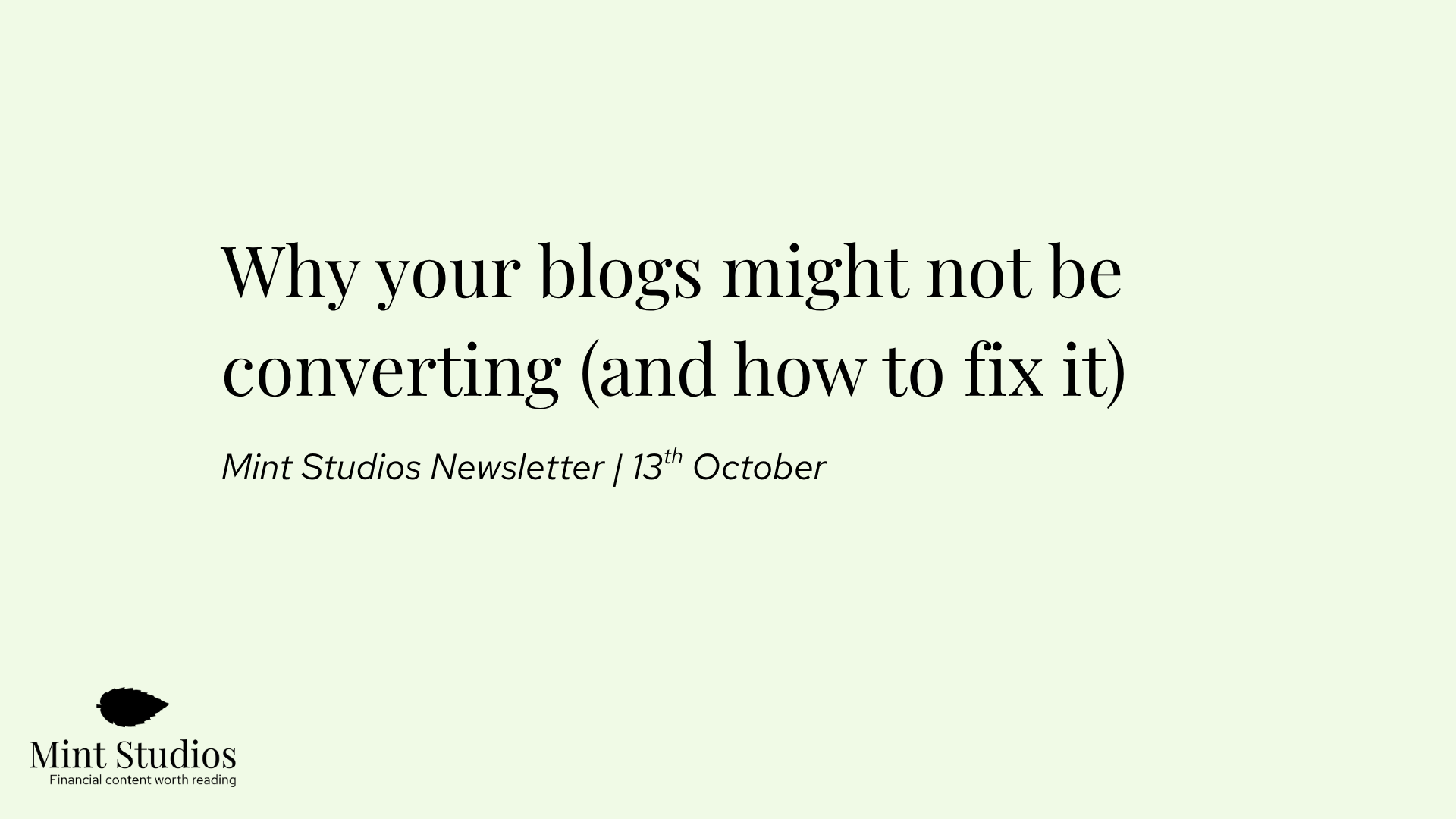We’re hiring! Mint Studios is growing and we’re looking for a full-time UK-based Content Strategist to join our team. If you (or someone you know) are excited about creating high-quality content, running strategy, and working with some of the most interesting companies in fintech, check out the role here.
Hey folks,
Elliot here. At Mint, one of the first things we do when we first start working with a client is audit and optimize their existing content.
We start by looking for the low-hanging fruit: are there BOFU blogs that rank well but don’t bring in leads?
In many cases, there are. They’re often well-written and bring in decent traffic… but that traffic just isn’t turning into leads.
The reason for this is simple. The article doesn’t talk about their product enough.
In this email, I want to unpack why this happens so often, why it matters, and how to do it well without coming across as too “salesy” – and the amazing results it can often bring.
Why marketers avoid talking about their product (and why it’s a problem)
So where does this avoidance come from? In my experience, it’s down to two main concerns:
- The fear of sounding too salesy: Many marketers worry that mentioning the product will interrupt the “educational” flow, come across as pushy, or put readers off. There’s still a lingering belief that good content must be completely neutral and objective, and that discussing your product brings in bias that loses your reader’s trust.
- A lack of product understanding: Writers often don’t have enough exposure to the product. They haven’t sat through demos, spoken to sales, or explored customer use cases. Without that depth, they don’t feel confident explaining how the product works, so they stay vague and generic.
The irony is that by withholding product information (whether that’s a deliberate choice or through a lack of knowledge/resources on the writer's part), you’re not protecting the reader's experience: you’re actively weakening it.
When someone lands on a BOFU article, they’re not casually browsing. They’ve got a specific problem to solve, and they’re evaluating options. If you don’t give them the information they need, they’ll get it elsewhere: often from a competitor who’s less shy about showing how their product works.
In my view, an article is only biased when you misinform a reader. If you give the honest truth about why your product is a good fit, you’re providing valuable information.
How to write about your product (without being too salesy)
Of course, it’s absolutely possible to be too salesy in content. If a blog opens with “our solution is the best on the market,” most readers will quite rightly switch off immediately.
But most marketers already know not to do that. The real problem here is striking a balance between being helpful and ensuring that readers actually understand what your product does.
Here are a few tips to strike that balance:
1. Set up the problem first, then make space for the solution
Start by helping the reader understand the problem. Set the scene, outline the challenges, and give them a solid grasp of what’s going on. By the time you bring your product into the picture, they should already know what needs to happen: they just need the right tool to do it.
For example, if you’re writing about payment failures, begin by breaking down the different types, why they happen, and what they cost businesses. Show that you understand the stakes and the operational pain points. Once that foundation is in place, introducing your solution doesn’t feel forced. It just feels like the logical next step.
When you do talk about your product, don’t squeeze it into a single throwaway paragraph before the CTA. Explain how your product solves the problem, highlight the most relevant features, and make the link between pain points and capabilities clear.
2. Be specific, not vague: avoid superficial explanations
Avoid vague claims like “we make payments seamless.” They don’t help the reader evaluate your product, and they don’t build trust. It’s just fluff. Replace this with concrete statements that show exactly how you solve the problem. For example:
- “Our payment infrastructure has maintained 99.98% uptime over the past 12 months.”
- “You can connect to more than 20 payment methods through a single API.”
- “Merchants using our solution see an average 3.2% uplift in approval rates.”
Specifics make the content more useful, build credibility, and differentiate you from competitors who rely on empty slogans. Wherever possible, support these details with real examples, case studies, or simple diagrams to make the impact clear and tangible.
3. Focus on the features and benefits that your reader cares about
Don’t overwhelm your reader with a long list of features without tying it back to the main point of the article.
Instead, focus on the features that are most relevant to the specific problem the piece is addressing, and make that connection clear.
For example, if the article is about speeding up merchant onboarding, the product section should concentrate on the functionality that actually enables that, and explain the impact in practical terms.
Other features can still be mentioned, but they shouldn’t compete for attention. A quick nod and an internal link to ‘learn more’ are often enough to show the product’s breadth, while keeping the spotlight on what matters most for the topic at hand.
A real example: how improving the product section in one blog led to 3x more conversions for our client
To show the impact of refining your product section, here’s a real example.
Our client is a leading global FX and international payments provider, and already had a blog post performing well in search: How to source wholesale using 1688.com outside China.
The article was ranked at number 4, and we saw an opportunity to strengthen performance. One of the changes we made to this piece was overhauling the product section to provide more detailed information about how WorldFirst supports businesses sourcing from overseas.
The original article went live in December 2024, and we optimized the article in March 2025. So, did talking about the product in more detail positively impact conversions?
Here’s what we saw:

When we compared the first four months of performance (December–March) with the subsequent four months after the optimization (April-July), we saw a 3x increase in conversions.
Crucially, the rankings didn’t actually improve, yet we generated more leads. This demonstrates how much you can impact conversions just by improving your product content.
The takeaway: clear, focused product content converts interested readers into customers
You don’t need to create brand-new content to see results. Often, it’s about finding the right articles – especially those that already rank – and strengthening the product sections within them. As we saw with the example above, that alone can drive a meaningful lift in conversions.
Our advice:
- Audit your existing BOFU content and flag articles that rank well but aren’t generating many leads.
- Strengthen the product sections so they clearly show how your solution solves the problem the article addresses.
- Be confident, clear, and specific. Don’t bury the product or tack it on at the end. Make it a meaningful part of the article.
Mint Studios Recommended Reads
- How to Write About Your Product In Your Content [And Increase Conversions]
- What Good BOFU Content Looks Like (And Tips on Creating it)
- Case Study: How Content Helped a Niche Financial Company Grow Website Inbound Enquiries by 58%
Thanks for reading,
Elliot and the Mint team 🎉
We help financial services and fintech companies acquire customers and position themselves as experts with content marketing. Learn more about what we do.










